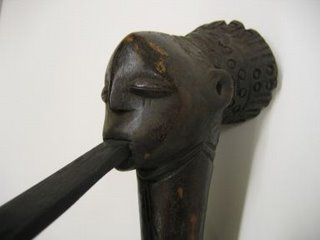2002 North Main Street
Santa Ana, California 92706
TEL: 714.567.3600
Luba Adze
Ceremonial Adze with Blade Emanating from Mouth, 20th Century
Luba Culture; Democratic Republic of the Congo
Wood and Iron; 6 3/4 x 2 5/8 x 9 5/8 in.
Gift of Dr. and Mrs. Daniel Solomon
F79.27.14
This adze made by an unknown Luba artist is a fine example of artistic mastery of wood and iron. Even the discoloration that has occurred through use lends to the overall beauty of the piece. The adze is most likely not a utilitarian tool but a piece of regalia and a symbol of status. Most striking is the tongue-like triangular blade that extends from mouth of the female head. This is quite captivating as the artist has created a piece that at once displays complete serenity and a violent interaction. Serenity and violence are not the only concepts at play here; the iron adze also is symbolic of life and death. It cannot be ignored that this is indeed a weapon capable of inflicting harm. At the same time it is a tool associated with societal progress as metal has contributed to the improvement of living standards especially in terms of agriculture.

The Luba live in the savannah region of the Democratic Republic of Congo, Africa. Their kingdoms were at their zenith between the 17th and 19th century. Excavations have revealed that advanced metallurgy skills have been practiced for over 1500 years. Luba blacksmiths are regarded as holders of secret knowledge, possessing skills that according to their lore have been handed down from a mythological hero. This hero is also credited for forming kingship amongst the Luba, forever binding the relationship between kingship and iron. To make or to hold an adze then is to commemorate Luba origin and to wield an object that embodies royalty and power. The Luba have a strong oral tradition and maintain complex visual associations. The frog found under the figure’s neck likely congers a connection to an event or story readily recalled by a Luba viewer. The female head with elaborate hair style and marks of scarification under her eyes is stunning. The artist has paid great attention to the proportions and balance of the face. A slightly pointed chin and forehead lend both grace and a life-like quality that speak to the artist’s proficiency. The female form is common in Luba art as women hold high status serving as life-giving mothers, priestesses and other high ranking officials. In addition only a woman’s body was believed to be strong enough to embody the spirit of a deceased king. In accepting this honor the woman would also inherit the king’s regalia. Again, the concepts of transformation and life and death are reiterated in this adze in the combination of female and metal. All text and images under copyright. Please contact Collection Department for permission to use. Information subject to change with additional research.
Luba Culture; Democratic Republic of the Congo
Wood and Iron; 6 3/4 x 2 5/8 x 9 5/8 in.
Gift of Dr. and Mrs. Daniel Solomon
F79.27.14
This adze made by an unknown Luba artist is a fine example of artistic mastery of wood and iron. Even the discoloration that has occurred through use lends to the overall beauty of the piece. The adze is most likely not a utilitarian tool but a piece of regalia and a symbol of status. Most striking is the tongue-like triangular blade that extends from mouth of the female head. This is quite captivating as the artist has created a piece that at once displays complete serenity and a violent interaction. Serenity and violence are not the only concepts at play here; the iron adze also is symbolic of life and death. It cannot be ignored that this is indeed a weapon capable of inflicting harm. At the same time it is a tool associated with societal progress as metal has contributed to the improvement of living standards especially in terms of agriculture.

The Luba live in the savannah region of the Democratic Republic of Congo, Africa. Their kingdoms were at their zenith between the 17th and 19th century. Excavations have revealed that advanced metallurgy skills have been practiced for over 1500 years. Luba blacksmiths are regarded as holders of secret knowledge, possessing skills that according to their lore have been handed down from a mythological hero. This hero is also credited for forming kingship amongst the Luba, forever binding the relationship between kingship and iron. To make or to hold an adze then is to commemorate Luba origin and to wield an object that embodies royalty and power. The Luba have a strong oral tradition and maintain complex visual associations. The frog found under the figure’s neck likely congers a connection to an event or story readily recalled by a Luba viewer. The female head with elaborate hair style and marks of scarification under her eyes is stunning. The artist has paid great attention to the proportions and balance of the face. A slightly pointed chin and forehead lend both grace and a life-like quality that speak to the artist’s proficiency. The female form is common in Luba art as women hold high status serving as life-giving mothers, priestesses and other high ranking officials. In addition only a woman’s body was believed to be strong enough to embody the spirit of a deceased king. In accepting this honor the woman would also inherit the king’s regalia. Again, the concepts of transformation and life and death are reiterated in this adze in the combination of female and metal. All text and images under copyright. Please contact Collection Department for permission to use. Information subject to change with additional research.


Comments